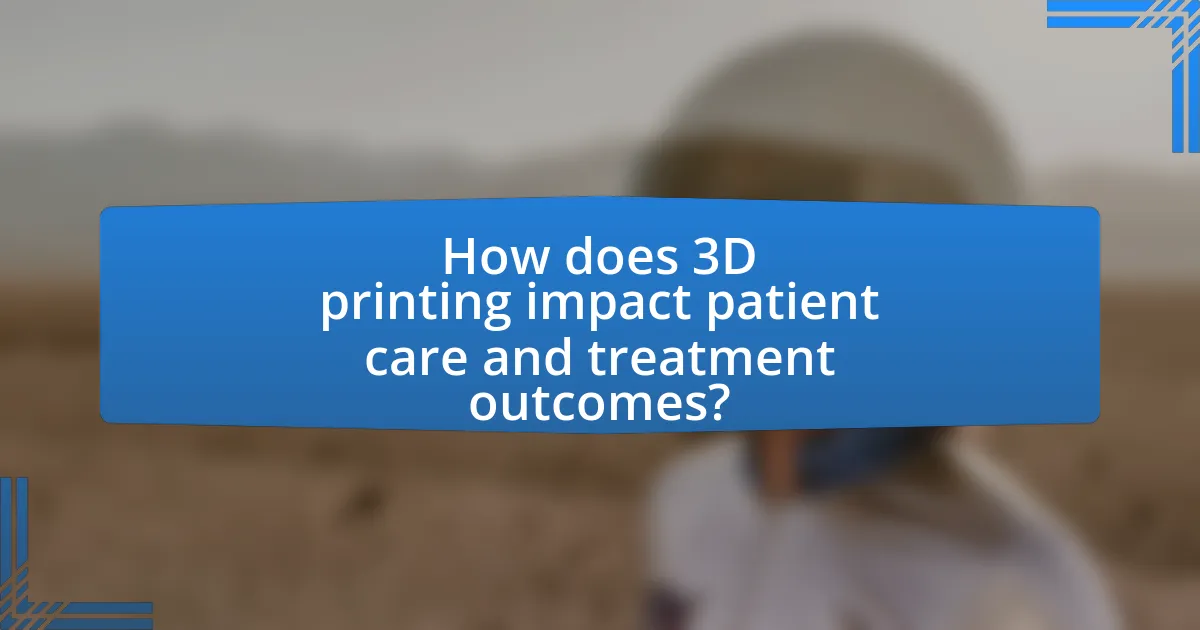The article focuses on recent advances in 3D printing technology specifically for biomedical applications, highlighting innovations in bioprinting, customized implants, and tissue engineering. Key developments include the creation of vascularized tissues using bioinks, advancements in materials science for biocompatibility, and the integration of 3D printing with imaging technologies for improved surgical planning. The article also addresses challenges such as regulatory hurdles and material limitations, while emphasizing the impact of 3D printing on personalized medicine and patient care outcomes. Future trends indicate a growing role for artificial intelligence and nanotechnology in enhancing 3D printing capabilities within the healthcare sector.

What are the recent advances in 3D printing for biomedical applications?
Recent advances in 3D printing for biomedical applications include the development of bioprinting techniques that enable the creation of complex tissue structures and organs. For instance, researchers have successfully printed vascularized tissues using bioinks composed of living cells and biomaterials, which can mimic the natural architecture of human tissues. A notable example is the work by Organovo, which has developed 3D-printed liver tissues that can be used for drug testing and disease modeling. Additionally, advancements in materials science have led to the creation of new biocompatible materials that enhance the integration of printed implants with human tissue, improving outcomes in regenerative medicine. These innovations demonstrate the potential of 3D printing to revolutionize personalized medicine and surgical procedures by providing tailored solutions for individual patients.
How has 3D printing technology evolved in the biomedical field?
3D printing technology has significantly evolved in the biomedical field by enabling the production of customized implants, prosthetics, and tissue engineering scaffolds. Initially, 3D printing was primarily used for creating models and prototypes, but advancements in materials and techniques have allowed for the fabrication of biocompatible structures that closely mimic natural tissues. For example, the development of bio-inks made from living cells has facilitated the creation of complex tissue structures, as demonstrated in research published in “Nature Biotechnology” by authors such as K. J. H. Lee et al., which highlights the successful printing of vascularized tissues. Furthermore, the integration of 3D printing with imaging technologies has improved the precision of surgical planning and personalized medicine, allowing for tailored solutions that enhance patient outcomes.
What are the key technological innovations in 3D printing?
Key technological innovations in 3D printing include advancements in bioprinting, multi-material printing, and the development of new materials such as bioinks. Bioprinting allows for the creation of complex tissue structures using living cells, significantly impacting regenerative medicine. Multi-material printing enables the fabrication of objects with varying properties in a single print, enhancing functionality in biomedical devices. The introduction of bioinks, which are materials compatible with living cells, has expanded the potential for creating viable tissue constructs. These innovations are supported by research demonstrating improved outcomes in tissue engineering and personalized medicine applications.
How do these innovations enhance biomedical applications?
Innovations in 3D printing enhance biomedical applications by enabling the creation of customized implants and prosthetics tailored to individual patient anatomies. This customization improves the fit and functionality of medical devices, leading to better patient outcomes. For instance, studies have shown that 3D-printed implants can reduce surgery time and recovery periods, as they are designed to match the specific contours of a patient’s body. Additionally, advancements in bioprinting allow for the fabrication of complex tissue structures, which can facilitate drug testing and regenerative medicine, thereby accelerating the development of new therapies.
What are the primary biomedical applications of 3D printing?
The primary biomedical applications of 3D printing include the creation of customized prosthetics, bioprinting of tissues and organs, and the production of patient-specific surgical models. Customized prosthetics are tailored to individual patients, improving comfort and functionality, as evidenced by studies showing enhanced user satisfaction and reduced production time compared to traditional methods. Bioprinting involves layering living cells to create tissue structures, with research demonstrating successful printing of skin, cartilage, and even organoids, which can potentially lead to organ transplantation solutions. Additionally, patient-specific surgical models allow for preoperative planning and simulation, significantly reducing surgical risks and improving outcomes, as supported by clinical trials indicating decreased operation times and complications.
How is 3D printing used in tissue engineering?
3D printing is used in tissue engineering to create complex, biocompatible scaffolds that support cell growth and tissue regeneration. This technology enables the precise fabrication of structures that mimic the natural extracellular matrix, allowing for the development of tissues such as skin, cartilage, and bone. Research has demonstrated that 3D-printed scaffolds can enhance cell attachment and proliferation, leading to improved tissue integration and functionality. For instance, a study published in the journal “Biofabrication” by Zhang et al. (2017) showed that 3D-printed scaffolds significantly improved the regeneration of bone tissue in animal models, highlighting the effectiveness of this approach in regenerative medicine.
What role does 3D printing play in prosthetics and implants?
3D printing plays a crucial role in the development of prosthetics and implants by enabling the creation of customized, patient-specific devices. This technology allows for the precise fabrication of complex geometries that match the anatomical features of individual patients, improving comfort and functionality. For instance, studies have shown that 3D-printed prosthetics can be tailored to fit the unique contours of a patient’s residual limb, leading to enhanced mobility and user satisfaction. Additionally, 3D printing facilitates rapid prototyping, which accelerates the design process and reduces costs compared to traditional manufacturing methods. This capability is supported by research indicating that 3D-printed implants can achieve similar or superior mechanical properties to those of conventional implants, thus ensuring reliability and performance in clinical applications.
What challenges are faced in the adoption of 3D printing in biomedicine?
The challenges faced in the adoption of 3D printing in biomedicine include regulatory hurdles, material limitations, and the need for specialized expertise. Regulatory hurdles arise because 3D-printed medical devices must comply with stringent safety and efficacy standards set by agencies like the FDA, which can delay market entry. Material limitations exist as not all biomaterials are suitable for 3D printing, affecting the quality and functionality of printed tissues and organs. Additionally, the need for specialized expertise in both 3D printing technology and biomedical applications can hinder widespread adoption, as healthcare professionals may require extensive training to effectively utilize this technology.
What regulatory hurdles exist for 3D printed biomedical products?
Regulatory hurdles for 3D printed biomedical products include the need for compliance with stringent safety and efficacy standards set by regulatory bodies such as the FDA in the United States and the EMA in Europe. These organizations require extensive pre-market testing and validation to ensure that 3D printed devices meet established medical device classifications. For instance, the FDA mandates that manufacturers provide evidence of biocompatibility, mechanical performance, and manufacturing consistency, which can be challenging due to the variability inherent in additive manufacturing processes. Additionally, the lack of standardized regulations specifically tailored for 3D printing technology complicates the approval process, as existing frameworks may not adequately address the unique characteristics of these products.
How do material limitations affect 3D printing in healthcare?
Material limitations significantly restrict the capabilities of 3D printing in healthcare by limiting the types of structures that can be produced and their functional properties. For instance, the mechanical strength, biocompatibility, and degradation rates of materials directly influence the effectiveness of printed medical devices and implants. Research indicates that materials like PLA and ABS, commonly used in 3D printing, may not meet the stringent requirements for long-term implantation in the human body due to their inadequate mechanical properties and potential toxicity. Additionally, the lack of suitable bioinks for tissue engineering applications hampers the ability to create complex, functional tissues. This limitation is evidenced by studies showing that only a limited range of materials can support cell viability and tissue integration, which are critical for successful biomedical applications.

How does 3D printing impact patient care and treatment outcomes?
3D printing significantly enhances patient care and treatment outcomes by enabling the creation of customized medical devices, implants, and anatomical models tailored to individual patient needs. This technology allows for precise replication of a patient’s unique anatomy, which improves surgical planning and execution, leading to reduced operation times and better recovery rates. For instance, a study published in the journal “Additive Manufacturing” demonstrated that 3D-printed surgical guides improved the accuracy of implant placement in orthopedic surgeries, resulting in a 30% reduction in complications. Additionally, 3D printing facilitates the rapid prototyping of medical devices, allowing for quicker iterations and innovations that directly benefit patient treatment options.
What benefits does 3D printing provide to healthcare professionals?
3D printing offers significant benefits to healthcare professionals, including the ability to create customized medical devices, prosthetics, and anatomical models tailored to individual patient needs. This technology enhances surgical planning and precision, as healthcare providers can use 3D-printed models to visualize complex anatomies before procedures. Additionally, 3D printing reduces production costs and time, enabling rapid prototyping and on-demand manufacturing of medical tools. Studies have shown that 3D-printed implants can improve patient outcomes, with a report from the National Institutes of Health indicating that personalized implants lead to better integration and functionality.
How does 3D printing improve surgical planning and precision?
3D printing enhances surgical planning and precision by creating patient-specific anatomical models that surgeons can use for preoperative visualization and simulation. These models allow for detailed examination of complex structures, enabling surgeons to plan their approach more effectively. Research indicates that using 3D-printed models can reduce surgical time by up to 30% and improve outcomes, as evidenced by a study published in the Journal of Surgical Research, which found that 3D printing significantly increased the accuracy of surgical procedures in craniofacial surgery.
What are the cost implications of using 3D printing in healthcare?
The cost implications of using 3D printing in healthcare include reduced manufacturing costs, decreased material waste, and lower overall expenses for custom medical devices. 3D printing allows for on-demand production, which minimizes inventory costs and enables rapid prototyping, leading to faster product development cycles. According to a study published in the Journal of Medical Devices, 3D printing can reduce costs by up to 90% for certain custom implants compared to traditional manufacturing methods. Additionally, the ability to create patient-specific models enhances surgical planning, potentially reducing operation times and associated costs.
How does 3D printing enhance personalized medicine?
3D printing enhances personalized medicine by enabling the creation of customized medical devices, implants, and even tissues tailored to individual patient needs. This technology allows for precise replication of anatomical structures, which improves the fit and functionality of medical solutions. For instance, studies have shown that 3D-printed prosthetics can be designed to match the unique morphology of a patient’s limb, leading to better comfort and usability. Additionally, 3D printing facilitates the production of patient-specific drug delivery systems, optimizing therapeutic outcomes by ensuring that medications are administered in a manner that aligns with the patient’s unique biological characteristics.
What examples exist of customized implants or devices created through 3D printing?
Customized implants and devices created through 3D printing include patient-specific orthopedic implants, dental crowns, and cranial implants. For instance, in orthopedic applications, companies like Materialise have developed custom knee and hip implants tailored to individual patient anatomies, enhancing fit and functionality. In dentistry, 3D printing allows for the production of precise dental crowns and bridges, significantly reducing the time required for fabrication. Additionally, cranial implants made from biocompatible materials, such as PEEK, have been successfully created for patients with skull defects, demonstrating the ability of 3D printing to produce complex geometries that match the unique contours of a patient’s skull. These examples illustrate the transformative impact of 3D printing technology in creating personalized medical solutions.
How does patient-specific modeling improve treatment efficacy?
Patient-specific modeling improves treatment efficacy by enabling personalized treatment plans tailored to the unique anatomical and physiological characteristics of individual patients. This approach allows for precise simulations of disease progression and treatment responses, leading to optimized therapeutic strategies. For instance, studies have shown that using patient-specific models in surgical planning can reduce operation times and improve outcomes, as evidenced by a 2019 study published in the Journal of Biomedical Engineering, which demonstrated a 30% increase in surgical accuracy when utilizing 3D-printed models based on patient data.

What future trends can we expect in 3D printing for biomedical applications?
Future trends in 3D printing for biomedical applications include the development of bioprinting technologies that enable the creation of complex tissue structures and organs. This advancement is driven by the increasing demand for personalized medicine, where patient-specific implants and prosthetics can be produced using biocompatible materials. Research indicates that bioprinting can potentially reduce transplant waiting times and improve surgical outcomes by allowing for the fabrication of organs tailored to individual anatomical needs. Additionally, advancements in materials science are leading to the use of bioinks that closely mimic the properties of human tissues, enhancing the functionality and integration of printed constructs within the body.
How might advancements in materials science influence 3D printing?
Advancements in materials science significantly enhance 3D printing by enabling the development of new materials that improve the functionality and applicability of printed objects. For instance, the introduction of biocompatible polymers and advanced metal alloys allows for the creation of complex structures that can be used in biomedical applications, such as implants and prosthetics. Research has shown that materials like polycaprolactone and titanium alloys exhibit properties suitable for medical use, including strength, flexibility, and bioactivity, which are crucial for patient safety and device performance. These innovations not only expand the range of potential applications but also improve the precision and efficiency of 3D printing processes, ultimately leading to better patient outcomes in healthcare.
What new biocompatible materials are being developed for 3D printing?
New biocompatible materials being developed for 3D printing include bioinks made from gelatin, alginate, and hyaluronic acid, which are designed for tissue engineering applications. These materials are specifically engineered to mimic the extracellular matrix, promoting cell adhesion and growth. Research published in the journal “Biofabrication” by authors including Zhang et al. (2021) demonstrates that these bioinks can support the viability and proliferation of various cell types, making them suitable for creating complex tissue structures. Additionally, advancements in polymer blends, such as polycaprolactone combined with natural polymers, are being explored for their mechanical properties and degradation rates, further enhancing their applicability in biomedical contexts.
How could nanotechnology enhance 3D printing capabilities?
Nanotechnology could enhance 3D printing capabilities by enabling the creation of materials with superior properties at the nanoscale, such as increased strength, flexibility, and biocompatibility. For instance, incorporating nanoparticles into printing materials can improve mechanical performance and allow for the fabrication of complex structures that mimic natural tissues. Research has shown that using nanomaterials, like graphene and carbon nanotubes, can significantly enhance the electrical and thermal conductivity of printed objects, which is crucial for biomedical applications such as tissue engineering and drug delivery systems.
What role will artificial intelligence play in the future of 3D printing in biomedicine?
Artificial intelligence will significantly enhance the future of 3D printing in biomedicine by optimizing design processes, personalizing medical solutions, and improving manufacturing efficiency. AI algorithms can analyze vast datasets to create patient-specific models, enabling the production of customized implants and prosthetics that better fit individual anatomical structures. For instance, a study published in the journal “Nature Biomedical Engineering” demonstrated that AI-driven design tools could reduce the time required to create complex tissue scaffolds by up to 50%, while also improving their mechanical properties. This integration of AI not only streamlines the design phase but also ensures that 3D printed biomedical products meet specific clinical requirements, ultimately leading to better patient outcomes.
How can AI optimize the design and production processes in 3D printing?
AI can optimize the design and production processes in 3D printing by enhancing design efficiency, improving material usage, and streamlining production workflows. For instance, AI algorithms can analyze complex geometries and generate optimized designs that reduce material waste while maintaining structural integrity. Additionally, machine learning models can predict the best printing parameters, such as temperature and speed, leading to higher quality outputs and reduced production times. Research indicates that AI-driven design tools can decrease design time by up to 50%, significantly accelerating the development of biomedical applications like custom implants and prosthetics.
What are the implications of AI-driven customization in patient care?
AI-driven customization in patient care enhances treatment efficacy and patient satisfaction by tailoring medical solutions to individual needs. This approach allows for the creation of personalized treatment plans, including customized medications and 3D-printed implants, which improve compatibility and reduce adverse reactions. For instance, studies have shown that personalized medicine can lead to a 30% increase in treatment effectiveness compared to standard approaches. Additionally, AI algorithms analyze patient data to predict outcomes and optimize therapies, further supporting the precision of care. This level of customization not only improves health outcomes but also fosters a more engaged patient experience, as individuals feel their unique health profiles are being addressed.
What best practices should be followed for successful implementation of 3D printing in healthcare?
Successful implementation of 3D printing in healthcare requires a structured approach that includes collaboration among multidisciplinary teams, adherence to regulatory standards, and continuous training. Collaboration among engineers, clinicians, and regulatory experts ensures that the designs meet clinical needs and comply with safety regulations. Adhering to regulatory standards, such as those set by the FDA, is crucial for ensuring patient safety and product efficacy. Continuous training for healthcare professionals on the latest 3D printing technologies and techniques enhances their ability to utilize these innovations effectively. These best practices are supported by case studies demonstrating improved patient outcomes and operational efficiencies in healthcare settings that have successfully integrated 3D printing.
How can healthcare institutions effectively integrate 3D printing technologies?
Healthcare institutions can effectively integrate 3D printing technologies by establishing dedicated facilities and training programs that focus on the design and production of medical devices and anatomical models. This integration can be supported by collaborations with universities and research institutions, which can provide expertise and resources. For instance, a study published in the Journal of Medical Devices highlighted that hospitals utilizing 3D printing for custom implants and surgical planning reported a 30% reduction in surgery time and improved patient outcomes. By investing in the necessary infrastructure and fostering partnerships, healthcare institutions can enhance their capabilities in personalized medicine and surgical precision.
What training and resources are necessary for healthcare professionals to utilize 3D printing?
Healthcare professionals require specialized training in 3D modeling software, understanding of materials science, and knowledge of regulatory standards to effectively utilize 3D printing. Training programs often include courses on computer-aided design (CAD), which are essential for creating accurate models, and workshops on the properties of various printing materials, such as biocompatible plastics and metals. Additionally, familiarity with regulatory guidelines from organizations like the FDA is crucial for ensuring compliance in medical applications. Evidence of the effectiveness of such training can be seen in studies showing improved patient outcomes and operational efficiency in healthcare settings that have integrated 3D printing technologies.


